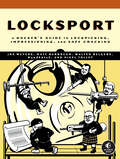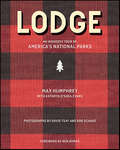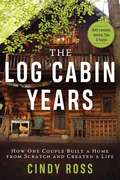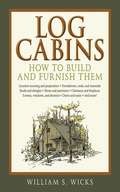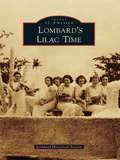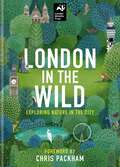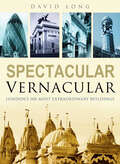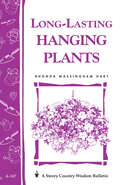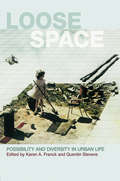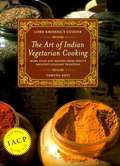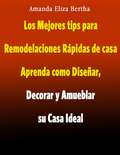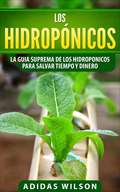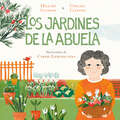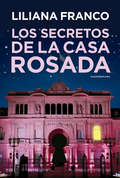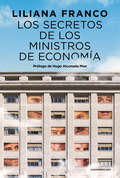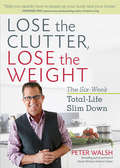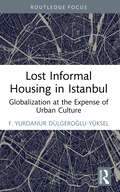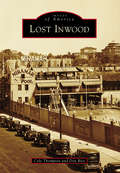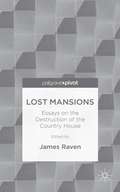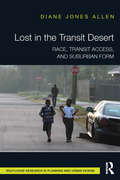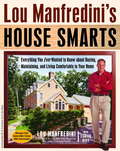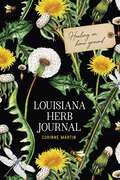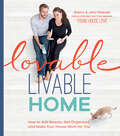- Table View
- List View
Locksport: A Hackers Guide to Lockpicking, Impressioning, and Safe Cracking
by Matt Burrough Jos Weyers Walter Belgers BandEAtoZ Nigel TolleyA comprehensive, fully illustrated guide to the fascinating sport of picking locks, Locksport is authored by five of the field&’s foremost champions. Together, they&’ll show you how to ethically, efficiently, and effectively bypass anything—from simple locks and safe dials to deadlocks and vaults.Welcome to the world of locksport, the sport of defeating locks. Whether you&’re new to the challenge of lockpicking or aiming for championship gold, this book serves as your definitive guide, packed with practical advice from a team of experts.DIVE INTO THE ESSENTIALS WITH LOCKSPORT FOUNDATIONSHow various locks work and how to maintain and disassemble practice locks What makes some locks more secure than othersThe laws, competitions, and communities that make up the world of locksportMASTER YOUR CRAFT WITH HANDS-ON TECHNIQUESHow to pick pin tumblers and lever locks, make impressions or craft a working key from a blank, and manipulate open combination safe locks How to work with picks, rakes, tension wrenches, files, magnification tools, safe-lock graphs, and depth-measuring instrumentsThe intricacies of security pins, wards, dimple locks, keyways, and antique locksGAIN THE COMPETITIVE EDGE WITH COMPETITION INSIGHTSThe ins and outs of competition setup and tools and how to host your own competitions Expert strategies for managing your nerves and gathering lock intelWhat it&’s like to participate in timed head-to-head competitions, PicTacToe™, escape challenges, and other lockpicking contestsFrom mastering your first padlock to conquering a competition, Locksport will show you how to take your skills to the next level—and have endless fun doing it.
Lodge: An Indoorsy Tour of America's National Parks
by Kathryn O'Shea-Evans Max HumphreyMax Humphrey shines a light on 10 rustic National Park lodges in all their airy, timeworn splendor. No historic photos here; the images of the architecture and interiors are as they look today, highlighting these storied places in a fresh, alluring way. Sure, the lobbies are the main stage, but Humphrey touches on grand dining rooms, guest rooms, and rustic canteens alike. He writes about the buildings themselves in terms of the historical goings-on at the time, why they were built, and the players involved, highlighting notable architectural moments and period-specific furnishings. A smattering of pop culture history adds extra bursts of levity throughout.
Log Cabin Years: How One Couple Built a Home From Scratch and Created a Life
by Cindy Ross"Cindy Ross is one of today's most eloquent and thoughtful writers on the connection between humans and the natural world."—Richard Louv, New York Times bestselling authorThe Log Cabin Years is the inspiring story of how award-winning author Cindy Ross and her husband, artist Todd Gladfelter—a young couple totally inexperienced in construction—built a log home using raw trees and without the use of power, how they recycled and used salvage to supplement their materials, and how the home went on to become a living, breathing part of their lives together. With a perfect mix of memoir and practical information, The Log Cabin Years explores the ways the couple not only developed their building skills but defined the values and virtues by which they would continue to live—self-confidence, freedom, and independence. As the cabin walls grew, so, too, did Cindy and Todd—as individuals and as partners. Building a home forced the couple to learn to argue constructively, communicate openly, and work within the parameters of each person&’s unique personality. The Log Cabin Years is a great example of how two people can learn to work together through difficult times, both mental and physical. For their efforts, they were able to build, and then live in, a beautiful home—debt free. From hosting Appalachian Trail hikers to offering a sanctuary for recovering veterans, from providing a place to homeschool and teach their children to launching Todd&’s very successful career as a chainsaw carving artist, the cabin has given back, fostering creativity, learning, and healing. Building your own home has long been an American dream. The desire and need to live more sustainably has seeped into all aspects of our lives. The Log Cabin Years will speak to all people who wish to live a more sustainable life, empower themselves, build relationships, learn skills, and perhaps create a hand-built home of their own.
Log Cabins: How to Build and Furnish Them
by William S. WicksEver wanted a cabin or little cottage in the woods but don't know where to start? With Log Cabins, author William S. Wicks offers clear, practical instructions on how to build your own log cabin-and furnish it, too-while harmonizing the structure's interior and exterior with the surrounding environment. Topics include: Location scouting and preparation Foundations, tools, and materials Roofs and shingles Floors, ceilings, and partitions Chimneys and fireplaces Screens, windows, and shutters Doors and stairs And more! With line drawings of lean-tos, Adirondack cabins, simple log structures, furniture, and more, this handy how-to manual provides easy-to-understand and must-know information to make your cabin dream a reality.
Lombard's Lilac Time
by Lombard Historical SocietyLombard has been called the "Lilac Village" since the late 1920s when William R. Plum, affectionately known as the "Colonel," bestowed his world-renowned lilac collection to the village for use as its first public park. Colonel Plum's 2.5-acre estate was known as Lilacia and began in 1911 after a trip to the Lemoine Lilac Gardens in France. By the time Plum passed away in 1927, he had amassed over 200 varieties of lilacs and had the largest collection of French hybrids in the world. Jens Jensen, the famous landscape architect, designed a public space out of Plum's lilac collection with winding paths of native limestone, tulips by the thousands, and a lily pond in the park. The first community-wide Lilac Festival was held in May of 1930, unveiling Jensen's Lilacia and including a Lilac Queen and Court, a pageant, parade, and wide variety of events and festivities celebrating the village's new park.
London in the Wild: Exploring Nature in the City
by London Wildlife Trust'London in the Wild is a timely opportunity to get out and explore all the wild spaces and natural places that exist alongside us. Both on your doorstep and on the other side of the river.' - Chris Packham A place of cars, concrete, lights, noise and pollution, London is a harsh, unyielding landscape created to meet the needs of people, not wildlife, but if you take the time to stop and look, you'll discover it is teeming with more than 15,000 species of flora, fungi and fauna, including marsh frogs, hedgehogs, short-eared owls and dragonflies. With London in the Wild as your guide, you can explore the city from your garden, local parks and community space, but also from its wetlands, woodlands and heaths. Along the way you'll discover the best places to see bluebells in springtime, the day-to-day life of a London Tube mouse and the activities of seals who make their home in the Thames.
London in the Wild: Exploring Nature in the City
by London Wildlife Trust'London in the Wild is a timely opportunity to get out and explore all the wild spaces and natural places that exist alongside us. Both on your doorstep and on the other side of the river.' - Chris Packham A place of cars, concrete, lights, noise and pollution, London is a harsh, unyielding landscape created to meet the needs of people, not wildlife, but if you take the time to stop and look, you'll discover it is teeming with more than 15,000 species of flora, fungi and fauna, including marsh frogs, hedgehogs, short-eared owls and dragonflies. With London in the Wild as your guide, you can explore the city from your garden, local parks and community space, but also from its wetlands, woodlands and heaths. Along the way you'll discover the best places to see bluebells in springtime, the day-to-day life of a London Tube mouse and the activities of seals who make their home in the Thames.
London's 100 Most Extraordinary Buildings: London's 100 Most Extraordinary Buildings
by David LongDelve into London's architectural curiositites and discover the unexpected gems waiting around every corner.London is full of extraordinary, enigmatic and, above all, unexpected buildings: a pirate castle in Camden, an art gallery made of shipping containers, underground ghost stations, and much more. Here David Long reveals the very best of the capital’s extraordinary buildings, some of which are passed by every day, hidden in plain sight.
Long-Lasting Hanging Plants: Storey's Country Wisdom Bulletin A-147 (Storey Country Wisdom Bulletin Ser.)
by Rhonda Massingham HartSince 1973, Storey's Country Wisdom Bulletins have offered practical, hands-on instructions designed to help readers master dozens of country living skills quickly and easily. There are now more than 170 titles in this series, and their remarkable popularity reflects the common desire of country and city dwellers alike to cultivate personal independence in everyday life.
Loose Fit City: The Contribution of Bottom-Up Architecture to Urban Design and Planning
by Maurice Mitchell Bo TangDrawn from a lifetime’s experience of shared city-making from the bottom up, within rapidly expanding urban metabolisms in Delhi, Mumbai, Agra, Kathmandu, West Africa and London, Loose Fit City is about the ways in which city residents can learn through making to engage with the dynamic process of creating their own city. It looks at the nature and processes involved in loosely fitting together elements made by different people at different scales and times, with different intentions, into a civic entity which is greater than the sum of its parts. It shows how bottom-up learning through making can create a more vibrant and democratic city than the more flattened, top-down, centrally planned, factory made version. Loose Fit City provides a new take on the subject of architecture, defined as the study and practice of fitting together physical and cultural topography. It provides a comprehensive view of how the fourth dimension of time fits loosely together with the three spatial dimensions at different scales within the human horizon, so as to layer meaning and depth within the places and metabolism of the city fabric.
Loose Space: Possibility and Diversity in Urban Life
by Karen A. Franck Quentin StevensIn cities around the world people use a variety of public spaces to relax, to protest, to buy and sell, to experiment and to celebrate. Loose Space explores the many ways that urban residents, with creativity and determination, appropriate public space to meet their own needs and desires. Familiar or unexpected, spontaneous or planned, momentary or long-lasting, the activities that make urban space loose continue to give cities life and vitality. The book examines physical spaces and how people use them. Contributors discuss a wide range of recreational, commercial and political activities; some are conventional, others are more experimental. Some of the activities occur alongside the intended uses of planned public spaces, such as sidewalks and plazas; other activities replace former uses, as in abandoned warehouses and industrial sites. The thirteen case studies, international in scope, demonstrate the continuing richness of urban public life that is created and sustained by urbanites themselves Presents a fresh way of looking at urban public space, focusing on its positive uses and aspects. Comprises 13 detailed, well-illustrated case studies based on sustained observation and research by social scientists, architects and urban designers. Looks at a range of activities, both everyday occurrences and more unusual uses, in a variety of public spaces -- planned, leftover and abandoned. Explores the spatial and the behavioral; considers the wider historical and social context. Addresses issues of urban research, architecture, urban design and planning. Takes a broad international perspective with cases from New York, London, Berlin, Amsterdam, Rome, Guadalajara, Athens, Tel Aviv, Melbourne, Bangkok, Kandy, Buffalo, and the North of England.
Lord Krishna's Cuisine: The Art of Indian Vegetarian Cooking
by Yamuna DeviFrom the book: From appetizers, soups and salads to light meals and savories, beverages and sweets here are easy-to-follow instructions for glorious foods, simply prepared in an American kitchen.
Los Mejores tips para Remodelaciones Rápidas de Casa
by Adriana Rojas Amanda Eliza BerthaCuando sueña, deje su mente volar. No deje que cosas como dinero y ubicación estanquen el desarrollo de sus planes ideales para su casa perfecta. No hay razón para dejar que sus sueños sean aplastados por la realidad. En dejar que sus sueños crezcan sin restricciones, será capaz de crear el mejor resultado posible para sus arreglos de visa. En otras palabras, sueñe a lo grande. Este libro lo guiara a través de los pasos involucrados en diseñar, decorar y amueblas su casa idea.
Los hidropónicos: La guia suprema de los hidroponicos para salvar tiempo y dinero
by Adidas WilsonLa palabra hidroponía se originó del latín que simplemente significa "Trabajo con agua". En términos simples, la hidroponía es el arte de cultivar cultivos sin usar suelo. Cuando pensamos en el arte de la hidroponía, imaginamos plantas que crecen con las raíces suspendidas en el agua sin ningún medio. Bueno, esto es cierto, ya que es una forma de jardinería hidropónica que se ha denominado técnica de película de nutrientes o NFT. Al igual que cualquier otra cosa en la que te metas, el primer objetivo es lograr un plan. Tendrá que considerar el espacio que tienes disponible para el cultivo. Si está planificando la jardinería en espacios cerrados, asegúrese de que haya suficiente espacio para realizar el mantenimiento de rutina.
Los jardines de la abuela
by Chelsea Clinton Hillary Clinton¿Qué compartes con las personas a las que quieres?Abuela Dorothy compartió su amor por los jardines con su hija Hillary y con su nieta Chelsea. Les enseñó que los jardines son lugares mágicos de aprendizaje, asombrosos espacios para el descubrimiento, puntos de encuentro con la familia y bellas áreas donde compartir historias y celebrar acontecimientos especiales. Pero, sobre todo, les enseñó que en su jardín su amor crecía y florecía.En esta inspiradora y reconfortante historia de madre-hija, Hillary Rodham Clinton y Chelsea Clinton se unen para mostrar a los lectores cómo compartir las cosas que amamos con las personas que queremos puede crear fuertes y eternos vínculos entre generaciones.
Los secretos de la Casa Rosada
by Liliana FrancoLas mejores anécdotas que desde el regreso de la democracia esconden las paredes de la Casa Rosada, la Meca con la que sueñan todos los políticos. Como todas las casas, la Rosada tiene vida cotidiana. Pero su día a día no se parece al de todos los hogares, porque las decisiones que allí se cocinan modifican la existencia de millones de personas. Poca gente es parte de esa vida: además de los funcionarios y los empleados, están los periodistas acreditados, que permanecen allí muchas horas para conseguir noticias de primera mano. Detrás de cada novedad que ellos divulgan hay historias, anécdotas y episodios que merecen ser conocidos. Un militar se creyó presidente y cuando llegó se enteró de que no lo era. Durante el juicio a las Juntas en 1985, hubo un Falcon viejo, con la chapa oxidada, estacionado varios días en la vereda. Antonio Banderas comió su primer choripán en la terraza, donde por esos años trabajaban telefonistas hot y acudían las "chicas del bolsito". Hay una palmera moribunda en el patio y un ascensor del que Mauricio Macri desconfía. Por la Rosada pasaron muchos funcionarios memorables, y cada presidente dejó algún recuerdo a quienes lo trataron durante su mandato. Liliana Franco -que trabajó en ella casi dos décadas- reunió estas y otras historias que, como un espejo deformado, reflejan a su modo los distintos períodos que atravesó nuestra democracia.
Los secretos de los ministros de Economía
by Liliana FrancoLas mejores anécdotas que desde el regreso de la democracia esconden las paredes y pasillos del Palacio de Hacienda. ¿Cómo se gestó la salida de Luis Caputo del Banco Central? ¿A qué ministro apodan Chocoarroz? ¿Qué hizo Amado Boudou con su despacho? ¿Cómo recuerdan en el Ministerio a Roberto Lavagna, Alfonso Prat-Gay, Axel Kicillof y Guillermo Nielsen? ¿Cómo fueron las eternas peleas con el Fondo Monetario Internacional? ¿Quién fue el mejor jefe? ¿Y el peor? La preocupación por la economía ocupa los primeros puestos de las encuestas porque -para bien o para mal- afecta la vida cotidiana y determina nuestro futuro. Pensamos que, antes de ser tomadas, las medidas son analizadas, sopesadas y debatidas por expertos. Si la realidad a veces nos hace dudar de ello, Los secretos de los ministros de Economía revela que ese recelo puede ser acertado. Como hizo en Los secretos de la Casa Rosada, Liliana Franco nos guía esta vez por las oficinas, las salas y los pasillos del Palacio de Hacienda. Tras años de trabajo en ese ámbito, ella como pocos conoce el detrás de escena de muchas decisiones controversiales y los aspectos ocultos del ascenso o la caída de personajes clave. A su manera, las historias de este libro muestran un costado desconocido de las formas en que los gobernantes y sus funcionarios más cercanos ejercen el poder; y pueden explicar cómo nos va...
Lose the Clutter, Lose the Weight: The Six-Week Total-Life Slim Down
by Peter WalshAcheive significant weight loss, a calmer mind, and a more organized, happier, efficient lifeA houseful of clutter may not be the only reason people pack on extra pounds, but research proves that it plays a big role. A recent study showed that people with super-cluttered homes were 77 percent more likely to be overweight or obese! Why? Organization guru Peter Walsh thinks it's because people can't make their best choices—their healthiest choices—in a cluttered, messy, disorganized home.In Lose the Clutter, Lose the Weight, Walsh weaves together a 6-week program that leads you step-by-step through decluttering your home, your body, and your life. He'll help you:• Clear your home of excess "stuff" as you discover your vision for your personal space• Clear your body of excess pounds as you follow a healthy, super-simple eating and exercise plan• Clear your mind and spirit of the excess weight of too many possessionsWith a room-by room organizing guide, dietitian-approved eating plan, exercise physiologist–developed fitness program, and quizzes to get to the root of your problem, Lose the Clutter, Lose the Weight is the only book you need to help you clear the clutter and zap the pounds.
Lost Informal Housing in Istanbul: Globalization at the Expense of Urban Culture
by F. Yurdanur Dulgeroglu-YukselThe dynamics of globalization brought a radical change in megacities and tensions between the stakeholders and dwellers against top-down urban renewal policies. This unique book provides a worldview of multi-stakeholders in the urban housing market. With a longitudinal research approach, it paves the way for interdisciplinary researchers to critically assess the urban renewal projects and update such studies. The urban renewal processes are implemented without participation, and the book highlights field-based information for policymakers. The reader will find, with the information provided from the field, why participation is necessary for a sustainable urban development, why there are different types of urbanizations, and how it works under different conditions. Better understanding of the challenges of urban renewal processes in the world cities is intended with the focus on the changing informal settlements. Istanbul is a megacity, housing more than half of its dwellers in informal settlements. After many decades of self-upgrading and silently communicating with the local authorities, the informal sector had become adapted and maintained its living spaces. Unexpectedly, the end of the first decade of the 21st century marked a radical urban land valuation and international investments. Top-down interventions started with naming Istanbul the 2010 European Capital of Culture. Then came the Law of Urban Transformation, which meant the fast decline of squatter housing and the speedy loss of its cultural value of the mahalle spirit, place identity. The book will raise curiosity on why the time has come to change the perspectives about the informal urban sector.
Lost Inwood (Images of America)
by Cole Thompson Don RiceInwood, the northernmost neighborhood of Manhattan, has a rich yet little-known history. For centuries, the region remained practically unchanged--a quaint, country village known to early Dutch settlers as Tubby Hook. The subway's arrival in the early 1900s transformed the area, once scorned as "ten miles from a beefsteak," from farm to city virtually overnight. The same construction boom sparked an age of neighborhood self-discovery, when vestiges of the past--in the form of mastodon bones, arrowheads, colonial pottery, Revolutionary War cannonballs, and forgotten cemeteries--emerged from the earth. Waves of German, Irish, and Dominican immigrants subsequently produced a vibrant urban oasis with a big-city/small-town feel. Inwood has also been home to wealthy country estates, pre-integration sports arenas, and a lively waterfront culture. Famous residents have included NBA legend Kareem Abdul-Jabbar, Basketball Diaries author Jim Carroll, and Hamilton creator/star Lin-Manuel Miranda.
Lost Mansions: Essays on the Destruction of the Country House
by James RavenThis provocative volume stimulates debate about lost 'heritage' by examining the history of the hundreds of great houses demolished in Britain and Ireland in the twentieth century. Seven lively essays debate our understanding of what is meant by loss and how it relates to popular conceptions of the great house.
Lost in the Transit Desert: Race, Transit Access, and Suburban Form
by Diane Jones AllenIncreased redevelopment, the dismantling of public housing, and increasing housing costs are forcing a shift in migration of lower income and transit dependent populations to the suburbs. These suburbs are often missing basic transportation, and strategies to address this are lacking. This absence of public transit creates barriers to viable employment and accessibility to cultural networks, and plays a role in increasing social inequality. This book investigates how housing and transport policy have played their role in creating these "Transit Deserts," and what impact race has upon those likely to be affected. Diane Jones Allen uses research from New Orleans, Baltimore, and Chicago to explore the forces at work in these situations, as well as proposing potential solutions. Mapping, interviews, photographs, and narratives all come together to highlight the inequities and challenges in Transit Deserts, where a lack of access can make all journeys, such as to jobs, stores, or relatives, much more difficult. Alternatives to public transit abound, from traditional methods such as biking and carpooling to more culturally specific tactics, and are examined comprehensively. This is valuable reading for students and researchers interested in transport planning, urban planning, city infrastructure, and transport geography.
Lou Manfredini's House Smarts
by Lou ManfrediniLou Manfredini, aka Mr. Fix-It, is the trusted friend every homeowner wishes he or she had--someone who knows houses. In his fun, friendly, fully illustrated guide for both inexperienced and seasoned homeowners, he takes you through your entire house and around the yard, showing you how it all works and what to do when it doesn't. The result: You'll have a clear understanding of the systems that make up your house and gain the expert knowledge to proceed with any job, big or small--whether you're hiring a contractor or doing it yourself. Discover* How your house works: an anatomy lesson* The wonders of water--where it comes from and where it goes* Getting wired--the magic of electricity* Windows--ways to bring in the sunshine and keep out the drafts* The joys of being floored--good floor construction and maintenance* Wall power--it's not what's on them but what's in them that counts* Decorating secrets the pros don't like to sharePlus Lou Manfredini's sixty-minute home inspection, an essential tool list, and an ABC glossary of terms: from air duct to weather stripping!From the Trade Paperback edition.
Louisiana Herb Journal: Healing on Home Ground
by Corinne MartinIn a world of constant change and crisis, the relationship between humans and their environment has never been more vital. Louisiana Herb Journal invites readers into the world of medicinal herbs, introducing fifty herbs found in Louisiana, with details on identification, habitat, distribution, healing properties, and traditional uses, including instruction on popular preparation methods such as tinctures and teas. Interspersed with these practical details, herbalist Corinne Martin shares stories that foster a true connection between readers and the world around them, from tales of childhood cherry picking to harvest mishaps to folklife traditions passed down through the generations. Accessible to experienced and rookie herbalists alike, Louisiana Herb Journal offers a new way of looking at the natural world, getting to know one’s “home ground” through a lens of healing and participation.Family connections, an intimate knowledge of the surrounding lands and waters, strong community bonds, an irrepressible resilience, and a great capacity for celebrating life despite hardships are part and parcel of what it means to be from Louisiana. A celebration of the state and the cultures of those who live there, Louisiana Herb Journal reflects on the value of medicinal herbs in promoting personal healing and addressing current challenges to the state’s environmental and economic stability. Readers will gain a deeper recognition of the natural wealth Louisiana enjoys and the ways that our stewardship of wild plants can impact our personal health as well as the state’s ecological future.
Lovable Livable Home: How to Add Beauty, Get Organized, and Make Your House Work for You
by Sherry Petersik John PetersikThis New York Times bestselling book is packed with thoughtful advice and inspiring photos to help you create a home filled with beauty and meaning. In the three years since Sherry and John Petersik wrote their bestselling book Young House Love, they have bought a new house and had a new baby, and they have seen their design perspective evolve right along with their family. In their latest book, they’ve set out to prove that just because you have kids or pets doesn’t mean you’re sentenced to floors overrun with toys or furniture covered in plastic. Through never-before-seen makeovers in the Petersiks’ own house, doable DIY projects, and a gallery of other inspiring spaces, Lovable Livable Home shows how beautiful homes can be functional too.
